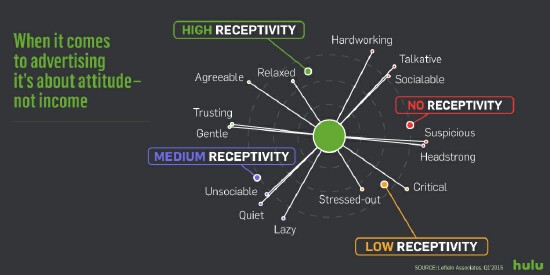Hulu: When It Comes to Advertising It’s Not Income, It’s Attitude

Hulu’s Peter Naylor, Senior Vice President of Advertising Sales, and Justin Fromm, Director, Ad Sales Research co-authored this column.
With the advent of on-demand viewing, control has shifted from those who deliver content to those who consume it.
This change is driving renewed pronouncements of the demise of the current TV advertising model. First the DVR, and now the growth in ad-blocking software provide naysayers with all the “evidence” they need to argue that consumers hate ads. An Ad Age cover story declaring consumers’ “war on advertising” asks the industry, “What are you going to do about it?”
Earlier this year, we partnered on robust research with Leflein Associates and have found that few TV viewers are truly ad avoiders. Our research reveals that viewers fall into four categories that center around their attitudes toward advertising: High, medium, low and no receptivity. The four groups do not vary greatly in their composition across gender, age, income or family size variables; the defining characteristic driving their attitudes toward ads is their personality.
The vast majority of TV viewers understand the value proposition of ad-supported content. The “high” and “medium” receptivity groups account for two-thirds of TV viewers. Highly receptive viewers enjoy advertising and are likely to share engaging ads with others. They tend to be relaxed and agreeable in personality, making them generally trusting and less likely to watch ads in a defensive mindset. “High” and “medium” receptivity viewers don’t see ads as an inconvenience. It’s safe to say marketers and publishers alike are happy with these groups.
One-quarter of the respondents in our study had “low” receptivity to ads; they dislike the way ads are presented to them in long mid-roll pods, but generally accept advertising. The opportunity advertisers have with this segment is sizable. Perhaps people don’t really dislike ads so much as they dislike irrelevance? With this group, the rise of ad relevance through data and ad tech cannot come fast enough before publishers and marketers lose them to the ad-blocking creep that’s on the rise.
Just seven percent of all viewers can be qualified as true ad avoiders, people who make every effort to watch content without any advertising. Their personality traits map to suspicious and headstrong, traits that lead them to respond negatively toward direct sales appeals and to persist in finding ways to avoid ads. This is the segment of the audience we most keenly have in mind at Hulu with our new commercial-free plan. Without a commercial-free option, we would frankly never appeal to this audience.

Advertising acceptance is demographically neutral. It isn’t so much age, gender or income, but rather personality that drives consumers’ attitudes towards advertising.
The media industry is in a period of transition, but the sky is not falling. We must understand our viewers and find ways to reach them that account for the new ways they are consuming content. The industry must evolve by recognizing that control has shifted to consumers and developing creative new models and messages that fit into the new framework.
The opinions and points of view expressed in this commentary are exclusively the views of the author and do not necessarily represent the views of MediaVillage/MyersBizNet management or associated bloggers.


